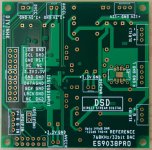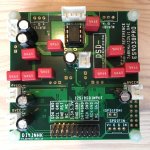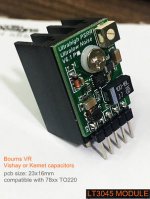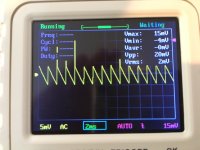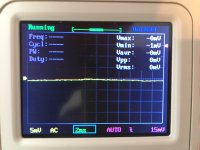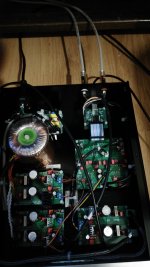Hi,
I am considering building a DAC and think these from DIYINHK based on ES9028PRO or ES9038PRO look interesting:
ES9028PRO ES9018 32bit Audio DAC PCB - DIYINHK
ES9038PRO XMOS DSD DXD 768kHz USB DAC with Bit-perfect volume control and SPDIF input - DIYINHK
Did anyone ever build and/or listen to one of these? Any experiences to share?
Thanks in advance,
Maartn
I am considering building a DAC and think these from DIYINHK based on ES9028PRO or ES9038PRO look interesting:
ES9028PRO ES9018 32bit Audio DAC PCB - DIYINHK
ES9038PRO XMOS DSD DXD 768kHz USB DAC with Bit-perfect volume control and SPDIF input - DIYINHK
Did anyone ever build and/or listen to one of these? Any experiences to share?
Thanks in advance,
Maartn
I haven't tried any of the current crop of ESS based DAC boards, but there is a thread here about tweaking an inexpensive ES9038Q2M eBay dac PCB.
ES9038Q2M Board
By the time you get the dac installed on one of these boards it's not so cheap. Unfortunately the photographs make it hard to tell how good the PCB design actually is.
The Twisted Pear DAC PCB is expensive but probably a safe bet.
There are also a number of 9038 dacs on eBay that may be worth a look with a view towards further modification.
ES9038Q2M Board
By the time you get the dac installed on one of these boards it's not so cheap. Unfortunately the photographs make it hard to tell how good the PCB design actually is.
The Twisted Pear DAC PCB is expensive but probably a safe bet.
There are also a number of 9038 dacs on eBay that may be worth a look with a view towards further modification.
The board arrived. See attached detailed pictures. I wanted to verify the opamps used. These are OPA1688 for the balanced outputs and NE5532P for single-ended. Good news because it means that I can definitely use the SilentSwitcher to feed the DAC! I will probably wait for Jan to organise a group buy, in order to avoid high shipping cost from the US.
Attachments
Here are the specs of some of the main parts I can make out:
- Oscillator is NDK NZ2520SD at 80 MHz
- Caps are Panasonic EEU-FR1E151 (ALUM 150UF 20% 25V RADIAL) and 1uK63 (can't make out the brand or S/N).
On the AVCC power: there are 2 separate connections - one for the left and one for the right channel. In between the power connector and the DAC chip there are a TI LP5907MFX-1.2 regulator, a 150uF cap, a diode marked MDD D7 and a few unmarked SMD caps.
Does this shed more light on the design? Let me know if there are any more interesting characteristics to look out for!
- Oscillator is NDK NZ2520SD at 80 MHz
- Caps are Panasonic EEU-FR1E151 (ALUM 150UF 20% 25V RADIAL) and 1uK63 (can't make out the brand or S/N).
On the AVCC power: there are 2 separate connections - one for the left and one for the right channel. In between the power connector and the DAC chip there are a TI LP5907MFX-1.2 regulator, a 150uF cap, a diode marked MDD D7 and a few unmarked SMD caps.
Does this shed more light on the design? Let me know if there are any more interesting characteristics to look out for!
The clock oscillator is a good one classified as low-phase noise assuming you don't get a dud. NDK makes some SDA suffex part number oscillators that they classify as ultra-low phase noise and that are specified down to 1Hz. The one you have looks like it might be their 2nd best type which is still very good, but not specified below 1kHz. There have been some reports of duds with much higher phase noise than most, which is luck of the draw (which NDK can do since the one you have isn't specified all the way down to 10Hz or 1Hz). Don't know if it is still an issue or not.
The 1.2 volt supplies aren't too critical, although they should be decoupled very close to the pins.
AVCC supplies are 3.3v, one for each side, as you say. Those are super-critical analog supplies for good sound quality and need to be separate from digital and clock power supplies.
You should use very high quality linear power supplies to power the board. Also, use fast turn off, soft-recovery rectifiers for the power supplies. Best to avoid switching power supplies because they tend to produce HF and RF junk that can get into the DAC electronics and cause ugly distortion. You might not know you even have a problem unless you have measurement equipment and or a very good reference DAC and amp to compare performance with (assuming very good switchers, for many switchers the issues are much more audible and it is much easier to know something is wrong, but it may not be obvious what exactly needs fixing).
One thing you might want to try with this DAC when you get it assembled is upsampling the digital input sample rate. If you use the SPDIF digital input on the DAC it is easy to do and would probably help with SQ (as I keep describing over in the ES9038Q2M thread). Choice of reconstruction filter may also vary depending on if upsampling is used or not. Reconstruction filters are still a problem with most DACs in that the filters do have audible effects, which they should not. Ideally, we are only supposed to hear the music, not the filter.
The 1.2 volt supplies aren't too critical, although they should be decoupled very close to the pins.
AVCC supplies are 3.3v, one for each side, as you say. Those are super-critical analog supplies for good sound quality and need to be separate from digital and clock power supplies.
You should use very high quality linear power supplies to power the board. Also, use fast turn off, soft-recovery rectifiers for the power supplies. Best to avoid switching power supplies because they tend to produce HF and RF junk that can get into the DAC electronics and cause ugly distortion. You might not know you even have a problem unless you have measurement equipment and or a very good reference DAC and amp to compare performance with (assuming very good switchers, for many switchers the issues are much more audible and it is much easier to know something is wrong, but it may not be obvious what exactly needs fixing).
One thing you might want to try with this DAC when you get it assembled is upsampling the digital input sample rate. If you use the SPDIF digital input on the DAC it is easy to do and would probably help with SQ (as I keep describing over in the ES9038Q2M thread). Choice of reconstruction filter may also vary depending on if upsampling is used or not. Reconstruction filters are still a problem with most DACs in that the filters do have audible effects, which they should not. Ideally, we are only supposed to hear the music, not the filter.
Last edited:
I currently don’t have any DSD content, so shouldn’t be a problem. Any other findings/advice on building it? What power supply, digital interface etc. do you use?
I soldered the board together. The only thing to mention is that with this particular kit less JST connectors are delivered than the board has room for. So you have to decide upfront where to use them - or buy some separately.
Thanks, Mark, for the insights and advice. For the power supply I was planning to use the SilentSwitcher -described elsewhere on this forum. What is the reason they the AVCC power supply needs to be separated from the other 3.3V connections?The clock oscillator ...
I am planning to use the I2S input. Does your suggestion on upsampling apply in that case?One thing you might want to try with this DAC when you get it assembled is upsampling the digital input sample rate.
I soldered the board together. The only thing to mention is that with this particular kit less JST connectors are delivered than the board has room for. So you have to decide upfront where to use them - or buy some separately.
Attachments
While looking for an affordable power supply for my new DAC, I found this little LT3045-based module on eBay for under $14 incl. postage. Ordered one to try it out. It seems to work very well! In the pictures you can see the "before" and "after" when applying this to the SMPS that came out of the box with my Beresford TC-7520SE Caiman DAC. I was pretty impressed. And it does sound noticeably better.
Attachments
I am planning to use the I2S input. Does your suggestion on upsampling apply in that case?
Yes. A very good one in that case would probably be this one: sandy AK4137 DAC SRC Audio 384K 32Bit DSD256 DSD IIS Conversion-in Headphone Amplifier from Consumer Electronics on Aliexpress.com | Alibaba Group
It does't include a USB interface but you can plug in an Amanero or similar board in the space provided.
What is the reason they the AVCC power supply needs to be separated from the other 3.3V connections?
It is just has to do with the internal architecture of ESS Sabre DAC chips. They require an AVCC supply that is the very incredibly best and cleanest it can be. The AVCC power input has no PSRR at all and any imperfection in power quality on those pins will have adverse audible consequences.
ESS does have a recommended circuit that is sufficient for the mobile Sabre chips such as ES9038Q2M, but it cannot supply enough current for the more recent PRO chips.
ES9028 pro probably doesn't sound that musical when people are unaware of, or somehow ignore too much of what ESS says is important to do right, likely if they miss any of it really. Not that a lot of it couldn't be fixed with some benefit. ESS does have a number of downloads on their website that are, IMHO, crucially important to study and to follow. You can tell a lot of times when people don't know about that information or didn't choose to follow it. I will give the link and hope people will read what is there to help reach a satisfying build: ESS Technology :: Downloads
Maybe the most important one is the one entitled 'Maximizing DAC Performance for Every Budget.' That one should be studied very carefully and every word taken to heart. These dacs can operate at extremely high levels of accuracy but not if certain things aren't right.
Maybe the most important one is the one entitled 'Maximizing DAC Performance for Every Budget.' That one should be studied very carefully and every word taken to heart. These dacs can operate at extremely high levels of accuracy but not if certain things aren't right.
Last edited:
The budget is not a concern for me, everything was done as ESS doc, each section of feeding has a separate regulator is 6 LT3042 in total, a transformer on the digital part and one on the analog part. All the components have been chosen with the most tight tolerance, resistance 0.1% everywhere, oscillator Cristek ..... The perfomences are very very good on the Ess9028pro but with the listening I like more the pcm1794 which me seems more natural for me, I think it's not because performence on paper and good that the device and musical as many like the amp lamp while the measures are very bad! It's a question of taste
While looking for an affordable power supply for my new DAC, I found this little LT3045-based module on eBay for under $14 incl. postage. Ordered one to try it out. It seems to work very well! In the pictures you can see the "before" and "after" when applying this to the SMPS that came out of the box with my Beresford TC-7520SE Caiman DAC. I was pretty impressed. And it does sound noticeably better.
Hi Maartn
Do you have a link for that power supply? I'd be interested in reading more into it.
Cheers
The budget is not a concern for me,
Happy for you that is the case. Might you consider acquiring a Benchmark DAC-3 for reference?
Hi Maartn
Do you have a link for that power supply? I'd be interested in reading more into it.
Cheers
The seller I bought it from doesn't carry it anymore, but this one is similar/same: LT3045 DC-DC 2-20V to 3V 3.3V 5V 9V 12V Linear Regulator Power Board Low Noise 699951779761 | eBay.
Those little LT3045 modules come with a Cset of 4.7uf. Fine for some things, but perhaps not quite optimal for something like AVCC, IMHO. Interestingly, the LT3045 data sheet suggests an ultra-low 1/f-noise application circuit but not aware of anyone building one and or measuring one as used in that way. However, since it is in the data sheet it appears the manufacturer thinks there is something to be gained by lowering 1/f noise for some applications, perhaps more than can be done with 22uf Cset.
Also of possible interest, ESS now has a small voltage reference chip for DACs. http://www.esstech.com/files/3414/5193/1543/ES9311_product_brief_121715.pdf
Also of possible interest, ESS now has a small voltage reference chip for DACs. http://www.esstech.com/files/3414/5193/1543/ES9311_product_brief_121715.pdf
Last edited:
- Status
- This old topic is closed. If you want to reopen this topic, contact a moderator using the "Report Post" button.
- Home
- Source & Line
- Digital Line Level
- Did anyone try one of these ES9028/ES9038 DAC kits?
 Relocated to the correct forum.
Relocated to the correct forum.